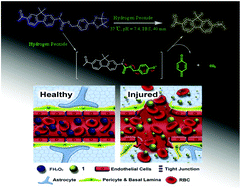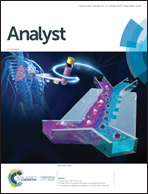Development of a ratiometric two-photon fluorescent probe for imaging of hydrogen peroxide in ischemic brain injury†
Abstract
Hydrogen peroxide (H2O2) plays crucial roles in immunological processes and has been revealed to be closely linked to the hypoxic–ischemic process. Thus, it is important to develop a reliable method for monitoring H2O2 in hypoxic–ischemic brain injury (HIBI). To achieve this, we report on a rationally designed fluorene-based ratiometric two-photon fluorescent probe for H2O2, i.e., FH2O2. The probe and fluorophore were tested under either one- or two-photon modes, respectively. After reacting with H2O2, the relative emission intensity ratio at wavelengths of 390–465 (Fblue) and 500–550 nm (Fyellow) of FH2O2 had a 6.5-fold increase (Fyellow/Fblue) within 40 min, and the maximal two-photon active cross-section value was detected as 66 GM at a wavelength of 750 nm. The probe exhibited high selectivity, low cytotoxicity, high sensitivity with a detection limit of 0.57 μM, and adequate photostability. After confirming satisfactory sensing performance of the probe in vitro, we were able to monitor H2O2in situ in mice with HIBI via two-photon microscopy, which could provide a potential method for clinical diagnosis during the neonatal HIBI process.



 Please wait while we load your content...
Please wait while we load your content...